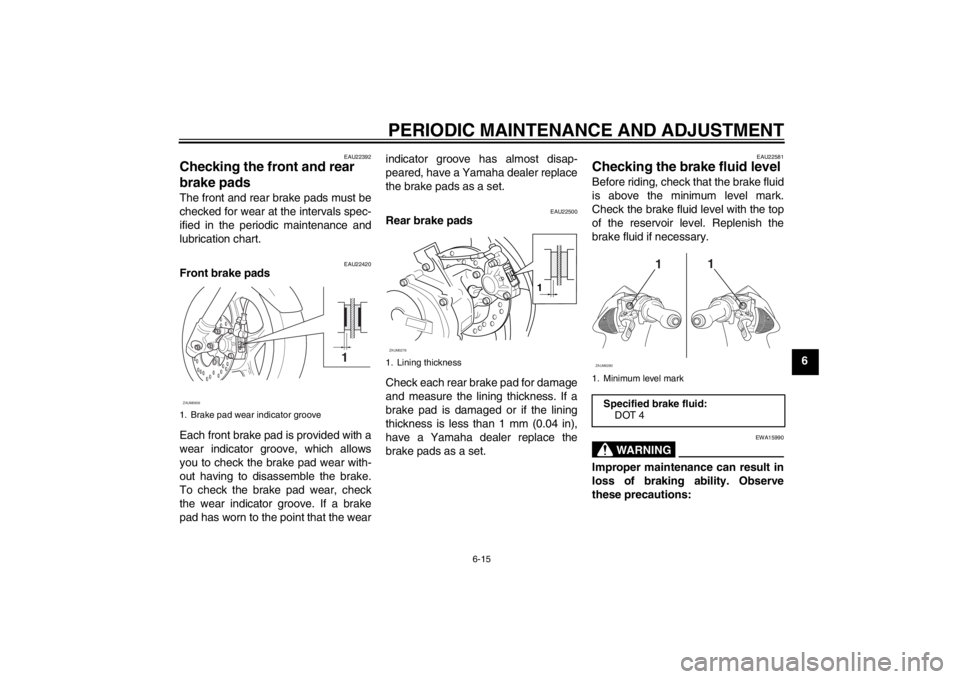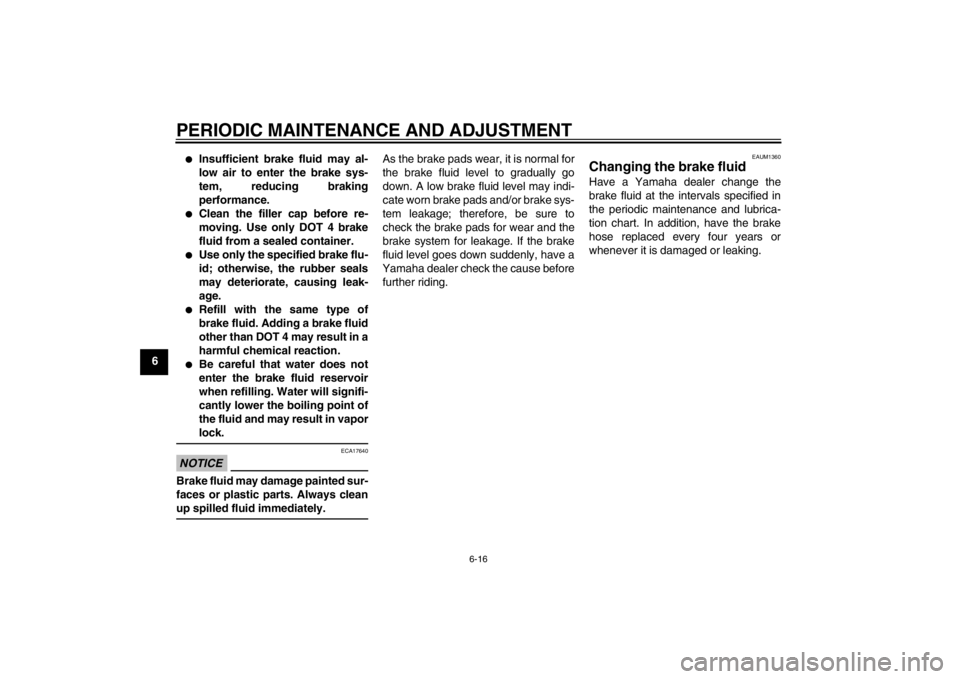2013 YAMAHA AEROX50 brake pads
[x] Cancel search: brake padsPage 6 of 74

TABLE OF CONTENTSSAFETY INFORMATION ..................1-1
Further safe-riding points ................1-5
DESCRIPTION ..................................2-1
Left view ..........................................2-1
Right view ........................................2-2
Controls and instruments.................2-3
INSTRUMENT AND CONTROL
FUNCTIONS.......................................3-1
Main switch/steering lock ................3-1
Indicator lights and warning light ....3-2
Speedometer unit (NS50N) .............3-3
Multi-function display (NS50)...........3-4
Handlebar switches ........................3-6
Front brake lever ............................3-7
Rear brake lever .............................3-7
Fuel and 2-stroke engine oil tank
caps .............................................3-8
Fuel .................................................3-9
Catalytic converter ........................3-10
2-stroke engine oil ........................3-10
Kickstarter .....................................3-11
Seats ............................................3-11
Storage compartment ...................3-12
Adjusting the shock absorber
assembly (if equipped) ...............3-13FOR YOUR SAFETY –
PRE-OPERATION CHECKS............. 4-1
OPERATION AND IMPORTANT
RIDING POINTS................................. 5-1
Starting a cold engine .................... 5-1
Starting off ...................................... 5-2
Acceleration and deceleration ........ 5-2
Braking ........................................... 5-2
Tips for reducing fuel
consumption ............................... 5-3
Engine break-in .............................. 5-3
Parking ........................................... 5-4
PERIODIC MAINTENANCE AND
ADJUSTMENT................................... 6-1
Periodic maintenance chart for
the emission control system ....... 6-2
General maintenance and
lubrication chart .......................... 6-3
Removing and installing the cowling
and panel .................................... 6-6
Checking the spark plug ................. 6-7
Final transmission oil ...................... 6-8
Coolant ........................................... 6-9
Cleaning the air filter element ...... 6-10
Adjusting the carburetor ............... 6-11
Checking the throttle grip free
play ........................................... 6-11
Tires ............................................. 6-12
Cast wheels .................................. 6-14Checking the front and rear brake
lever free play ........................... 6-14
Checking the front and rear brake
pads .......................................... 6-15
Checking the brake fluid level ...... 6-15
Changing the brake fluid .............. 6-16
Checking and lubricating
the throttle grip and cable ......... 6-17
Lubricating the front and rear
brake levers .............................. 6-17
Checking and lubricating the
centerstand ............................... 6-17
Checking the front fork ................. 6-18
Checking the steering .................. 6-19
Checking the wheel bearings ....... 6-19
Battery ......................................... 6-19
Replacing the fuse ....................... 6-21
Replacing the headlight bulb ....... 6-22
Replacing the tail/brake light
bulb ........................................... 6-23
Replacing a turn signal light
bulb ........................................... 6-23
License plate light ........................ 6-24
Replacing the auxiliary light bulb
(if equipped) .............................. 6-24
Troubleshooting ........................... 6-25
Troubleshooting charts ................ 6-26
SCOOTER CARE AND STORAGE... 7-1
Matte color caution ........................ 7-1
Care ............................................... 7-1U1PHE0E0.book Page 1 Wednesday, August 29, 2012 4:42 PM
Page 12 of 74

SAFETY INFORMATION
1-5
1Aftermarket Tires and Rims
The tires and rims that came with your
scooter were designed to match the
performance capabilities and to provide
the best combination of handling, brak-
ing, and comfort. Other tires, rims, siz-
es, and combinations may not be
appropriate. Refer to page 6-12 for tire
specifications and more information on
replacing your tires.
Transporting the Scooter
Be sure to observe following instruc-
tions before transporting the scooter in
another vehicle.
●
Remove all loose items from the
scooter.
●
Point the front wheel straight
ahead on the trailer or in the truck
bed, and choke it in a rail to pre-
vent movement.
●
Secure the scooter with tie-downs
or suitable straps that are attached
to solid parts of the scooter, such
as the frame or upper front fork tri-
ple clamp (and not, for example, to
rubber-mounted handlebars or
turn signals, or parts that could
break). Choose the location for thestraps carefully so the straps will
not rub against painted surfaces
during transport.
●
The suspension should be com-
pressed somewhat by the tie-
downs, if possible, so that the
scooter will not bounce excessive-
ly during transport.
EAU10373
Further safe-riding points ●
Be sure to signal clearly when
making turns.
●
Braking can be extremely difficult
on a wet road. Avoid hard braking,
because the scooter could slide.
Apply the brakes slowly when
stopping on a wet surface.
●
Slow down as you approach a cor-
ner or turn. Once you have com-
pleted a turn, accelerate slowly.
●
Be careful when passing parked
cars. A driver might not see you
and open a door in your path.
●
Railroad crossings, streetcar rails,
iron plates on road construction
sites, and manhole covers be-
come extremely slippery when
wet. Slow down and cross them
with caution. Keep the scooter up-
right, otherwise it could slide out
from under you.
●
The brake pads could get wet
when you wash the scooter. After
washing the scooter, check the
brakes before riding.
U1PHE0E0.book Page 5 Wednesday, August 29, 2012 4:42 PM
Page 31 of 74

FOR YOUR SAFETY – PRE-OPERATION CHECKS
4-1
4
EAU15596
Inspect your vehicle each time you use it to make sure the vehicle is in safe operating condition. Always follow the inspection
and maintenance procedures and schedules described in the Owner’s Manual.
WARNING
EWA11151
Failure to inspect or maintain the vehicle properly increases the possibility of an accident or equipment damage.
Do not operate the vehicle if you find any problem. If a problem cannot be corrected by the procedures provided in
this manual, have the vehicle inspected by a Yamaha dealer.Before using this vehicle, check the following points:
ITEM CHECKS PAGE
Fuel Check fuel level in fuel tank.
Refuel if necessary.
Check fuel line for leakage.3-9
2-stroke engine oil Check oil level in oil tank.
If necessary, add recommended oil to specified level.
Check vehicle for oil leakage.3-10
Final transmission oil Check vehicle for oil leakage. 6-8
Coolant Check coolant level in reservoir.
If necessary, add recommended coolant to specified level.
Check cooling system for leakage.6-9
Front brake Check operation.
If soft or spongy, have Yamaha dealer bleed hydraulic system.
Check brake pads for wear.
Replace if necessary.
Check fluid level in reservoir.
If necessary, add specified brake fluid to specified level.
Check hydraulic system for leakage.6-14, 6-15, 6-15
U1PHE0E0.book Page 1 Wednesday, August 29, 2012 4:42 PM
Page 32 of 74

FOR YOUR SAFETY – PRE-OPERATION CHECKS
4-2
4
Rear brake Check operation.
If soft or spongy, have Yamaha dealer bleed hydraulic system.
Check brake pads for wear.
Replace if necessary.
Check fluid level in reservoir.
If necessary, add specified brake fluid to specified level.
Check hydraulic system for leakage.6-14, 6-15, 6-15
Throttle grip Make sure that operation is smooth.
Check throttle grip free play.
If necessary, have Yamaha dealer adjust throttle grip free play and lubricate cable
and grip housing.6-11, 6-17
Wheels and tires Check for damage.
Check tire condition and tread depth.
Check air pressure.
Correct if necessary.6-12, 6-14
Brake levers Make sure that operation is smooth.
Lubricate lever pivoting points if necessary.6-17
Centerstand Make sure that operation is smooth.
Lubricate pivot if necessary.6-17
Chassis fasteners Make sure that all nuts, bolts and screws are properly tightened.
Tighten if necessary.—
Instruments, lights, signals
and switches Check operation.
Correct if necessary.—
Battery Check fluid level.
Fill with distilled water if necessary.6-19 ITEM CHECKS PAGE
U1PHE0E0.book Page 2 Wednesday, August 29, 2012 4:42 PM
Page 39 of 74

PERIODIC MAINTENANCE AND ADJUSTMENT
6-3
6
EAU17718
General maintenance and lubrication chart NO. ITEM CHECK OR MAINTENANCE JOBODOMETER READING
ANNUAL
CHECK 1000 km
(600 mi)6000 km
(3500 mi)12000 km
(7000 mi)18000 km
(10500 mi)24000 km
(14000 mi)
1 Air filter element Clean.√√
Replace.√√
2*Battery Check electrolyte level and specif-
ic gravity.
Make sure that the breather hose
is properly routed.√√√√√
3*Front brake Check operation, fluid level and
vehicle for fluid leakage.√√√√√√
Replace brake pads. Whenever worn to the limit
4*Rear brake Check operation, fluid level and
vehicle for fluid leakage.√√√√√√
Replace brake pads. Whenever worn to the limit
5*Brake hose Check for cracks or damage.
Check for correct routing and
clamping.√√√√√
Replace. Every 4 years
6*Brake fluid Replace. Every 2 years
7*Wheels Check runout and for damage.√√√√
8*Tires Check tread depth and for dam-
age.
Replace if necessary.
Check air pressure.
Correct if necessary.√√√√√
U1PHE0E0.book Page 3 Wednesday, August 29, 2012 4:42 PM
Page 51 of 74

PERIODIC MAINTENANCE AND ADJUSTMENT
6-15
6
EAU22392
Checking the front and rear
brake pads The front and rear brake pads must be
checked for wear at the intervals spec-
ified in the periodic maintenance and
lubrication chart.
EAU22420
Front brake pads
Each front brake pad is provided with a
wear indicator groove, which allows
you to check the brake pad wear with-
out having to disassemble the brake.
To check the brake pad wear, check
the wear indicator groove. If a brake
pad has worn to the point that the wearindicator groove has almost disap-
peared, have a Yamaha dealer replace
the brake pads as a set.
EAU22500
Rear brake pads
Check each rear brake pad for damage
and measure the lining thickness. If a
brake pad is damaged or if the lining
thickness is less than 1 mm (0.04 in),
have a Yamaha dealer replace the
brake pads as a set.
EAU22581
Checking the brake fluid level Before riding, check that the brake fluid
is above the minimum level mark.
Check the brake fluid level with the top
of the reservoir level. Replenish the
brake fluid if necessary.
WARNING
EWA15990
Improper maintenance can result in
loss of braking ability. Observe
these precautions:
1. Brake pad wear indicator groove
1
ZAUM0959
1. Lining thickness
1
ZAUM0278
1. Minimum level mark
Specified brake fluid:
DOT 4
11
ZAUM0280
U1PHE0E0.book Page 15 Wednesday, August 29, 2012 4:42 PM
Page 52 of 74

PERIODIC MAINTENANCE AND ADJUSTMENT
6-16
6
●
Insufficient brake fluid may al-
low air to enter the brake sys-
tem, reducing braking
performance.
●
Clean the filler cap before re-
moving. Use only DOT 4 brake
fluid from a sealed container.
●
Use only the specified brake flu-
id; otherwise, the rubber seals
may deteriorate, causing leak-
age.
●
Refill with the same type of
brake fluid. Adding a brake fluid
other than DOT 4 may result in a
harmful chemical reaction.
●
Be careful that water does not
enter the brake fluid reservoir
when refilling. Water will signifi-
cantly lower the boiling point of
the fluid and may result in vapor
lock.
NOTICE
ECA17640
Brake fluid may damage painted sur-
faces or plastic parts. Always clean
up spilled fluid immediately.
As the brake pads wear, it is normal for
the brake fluid level to gradually go
down. A low brake fluid level may indi-
cate worn brake pads and/or brake sys-
tem leakage; therefore, be sure to
check the brake pads for wear and the
brake system for leakage. If the brake
fluid level goes down suddenly, have a
Yamaha dealer check the cause before
further riding.
EAUM1360
Changing the brake fluid Have a Yamaha dealer change the
brake fluid at the intervals specified in
the periodic maintenance and lubrica-
tion chart. In addition, have the brake
hose replaced every four years or
whenever it is damaged or leaking.
U1PHE0E0.book Page 16 Wednesday, August 29, 2012 4:42 PM
Page 72 of 74

INDEX22-stroke engine oil................................. 3-10AAcceleration and deceleration................. 5-2
Air filter element, cleaning..................... 6-10
Auxiliary light bulb, replacing
(if equipped)........................................ 6-24BBattery................................................... 6-19
Brake fluid, changing ............................ 6-16
Brake fluid level, checking .................... 6-15
Brake lever, front..................................... 3-7
Brake lever, rear ..................................... 3-7
Brake levers, lubricating........................ 6-17
Braking .................................................... 5-2CCarburetor,adjusting ............................. 6-11
Care ........................................................ 7-1
Catalytic converter ................................ 3-10
Centerstand, checking and
lubricating ........................................... 6-17
Coolant.................................................... 6-9
Coolant temperature warning light .......... 3-3
Cowling and panel, removing and
installing................................................ 6-6DDimmer switch ........................................ 3-7EEngine break-in ....................................... 5-3FFinal transmission oil .............................. 6-8
Front and rear brake lever free play,
checking ............................................. 6-14
Front and rear brake pads, checking .... 6-15Front fork, checking .............................. 6-18
Fuel......................................................... 3-9
Fuel and 2-stroke engine oil tank caps ... 3-8
Fuel consumption, tips for reducing........ 5-3
Fuel level warning light ........................... 3-3
Fuse, replacing ..................................... 6-21
HHandlebar switches ................................ 3-6
Headlight bulb, replacing ...................... 6-22
High beam indicator light ........................ 3-2
Horn switch ............................................. 3-7IIdentification numbers ............................ 9-1
Indicator lights and warning light ............ 3-2KKickstarter............................................. 3-11LLicense plate light ................................. 6-24MMain switch/steering lock........................ 3-1
Maintenance and lubrication, periodic .... 6-3
Maintenance, emission control
system .................................................. 6-2
Matte color, caution ................................ 7-1
Model label ............................................. 9-1
Multi-function display (NS50).................. 3-4OOil level warning light.............................. 3-2PParking ................................................... 5-4
Part locations .......................................... 2-1SSafe-riding points.................................... 1-5
Safety information................................... 1-1Seats ..................................................... 3-11
Shock absorber assembly,
adjusting (if equipped) ........................ 3-13
Spark plug, checking ............................... 6-7
Specifications .......................................... 8-1
Speedometer unit (NS50N) ..................... 3-3
Starting a cold engine ............................. 5-1
Starting off ............................................... 5-2
Start switch.............................................. 3-7
Steering, checking................................. 6-19
Storage.................................................... 7-3
Storage compartment............................ 3-12
TTail/brake light bulb, replacing .............. 6-23
Throttle grip and cable, checking and
lubricating ........................................... 6-17
Throttle grip free play, checking ............ 6-11
Tires ...................................................... 6-12
Troubleshooting .................................... 6-25
Troubleshooting charts.......................... 6-26
Turn signal indicator light ........................ 3-2
Turn signal light bulb, replacing ............ 6-23
Turn signal switch ................................... 3-7VVehicle identification number .................. 9-1WWheel bearings, checking ..................... 6-19
Wheels .................................................. 6-14
U1PHE0E0.book Page 1 Wednesday, August 29, 2012 4:42 PM